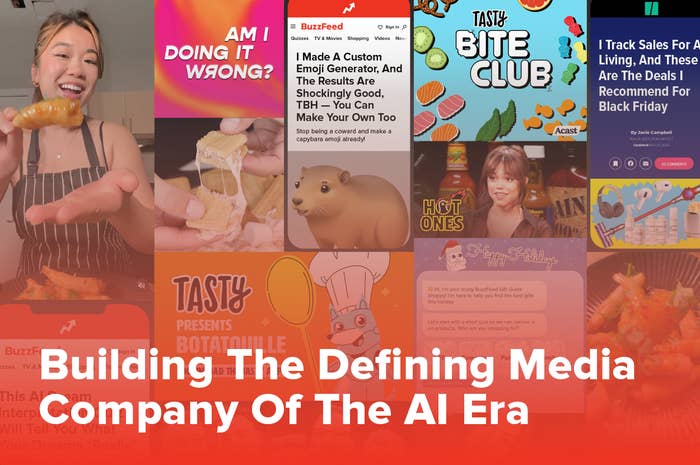
BuzzFeed has built and fostered the growth of some of the most iconic brands on the internet — BuzzFeed, HuffPost, Tasty, First We Feast and Hot Ones— by embracing new technologies, pioneering new formats and innovating to bring our content to life in new ways.
In this letter, I’d like to share my vision for our flagship BuzzFeed brand. In the future, I may talk more about our strategy for some of our other brands, but today my focus is on BuzzFeed, or as we like to call it internally, “Big Red.”
With the explosion of GenAI, we’re at the precipice of another technological revolution, and we have an opportunity once again to pioneer the future of media.
From BuzzFeed’s founding, we knew that “social content” would be a big deal, before we knew exactly what it would be. Our early teams did the foundational work to establish the core tenets on which we would build BuzzFeed: (1) identity, (2) fandom and (3) shareability, driven by the instant feedback loop of audience engagement data. This now seems obvious, but when BuzzFeed started it wasn’t the norm for content to be shareable, relatable, identity-affirming, or purpose-built to connect people into fandoms and affinity groups based on shared passions. Our teams were some of the first to apply the flood of consumer engagement data - clicks, comments, shares, time-spent and other unique reactions - to our content development process. Before many others, we understood that the Internet was a two-way medium and we made this feedback loop core to our model — giving us a strong competitive advantage.
Over the past 15 years, we’ve been part of this medium emerging, maturing and becoming ubiquitous. Our unique approach to media has inspired outlets as diverse as The New York Times and Mr. Beast. Over this period, BuzzFeed emerged as a leader in data-driven storytelling and a defining force in pop culture and entertainment. Today, BuzzFeed continues to be the biggest player in digital media, with vastly more time spent than widely known digital and legacy brands like Vox, Bustle, People, Condé Nast and Hearst.
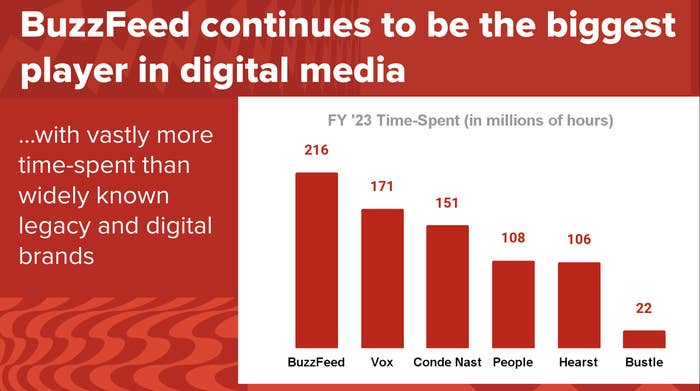
As everyone adopted the conventions of social media that our teams pioneered, it became harder to stand out. We face more competition from the many companies and creators who mirrored many of the approaches to content that we developed. Many people who grew up with BuzzFeed became creators, making content in a similar style for the big internet platforms, and we find ourselves competing with a generation who learned to make media from watching our videos and sharing our lists and quizzes. Though these creators do inspired work, they are limited by being out there on their own, without the ability to do R&D at scale and without a community of colleagues to support them and push their careers forward.
This is why I’m convinced the platforms are making a strategic mistake by not supporting media companies like ours. Creators are a cheap or free source of content for the platforms, but media companies bring so much more, including a content development infrastructure that is long-term oriented, and helps the platforms break out of the “local maximums” that limit the development of their services. They’re missing out on the chance to build sustainable, positive and socially-beneficial media ecosystems. Collaborations with publishers and media companies would also create a competitive moat for platforms, because it’s hard to compete with any single entity that aggregates the best of everything: premium content, creators and personal updates. Despite my best efforts, I haven’t been able to convince the platforms to cultivate a media ecosystem where quality publishers can thrive — when the allure of commoditized content, and zero and low-cost creator labor is impossible for platforms to resist.
This is a societal issue far beyond the scope of what BuzzFeed alone can fix. Instead, we will look for opportunities in the silver linings and make our own sustainable models. The truth is, people aren’t happy with infinite scrolling through algorithmically recommended short-form content. The experience is addictive and engagement numbers are strong, but that doesn’t mean people are satisfied. While it can often be entertaining, it leaves people feeling empty and wanting more: more depth, more community, and more control. This is our competitive opening, to offer the “more” so many crave.
The advancements in AI have opened up an opportunity to create a new medium that pushes digital media forward, powered by a breakthrough technology that makes entirely new experiences possible for the first time. I haven’t been this excited since our early days developing “social content” as a new medium. I see a tremendous opportunity in front of us to build the defining media company for the AI era.
HARNESSING OUR STRENGTHS AS THE PLATFORM LANDSCAPE SHIFTS
BuzzFeed - a brand that was built on the rise of social media and Facebook - has undergone an intense period of adaptation over the past few years as audience behavior has shifted. In 2020, Facebook-referred traffic to BuzzFeed was six times higher than direct traffic to our site. Today, Facebook is no longer a material source of referral traffic. From 2020 to 2023 Facebook traffic has declined 74%. Over that same period, our direct traffic has grown by 12%. Today the majority of traffic referrals are direct, from our app or internally generated through cross promotion and recirculation. As the platforms become walled gardens, people are still finding their way to us. We’ve completed the transition from being a Facebook ecosystem company to being a web company that controls our own destiny.
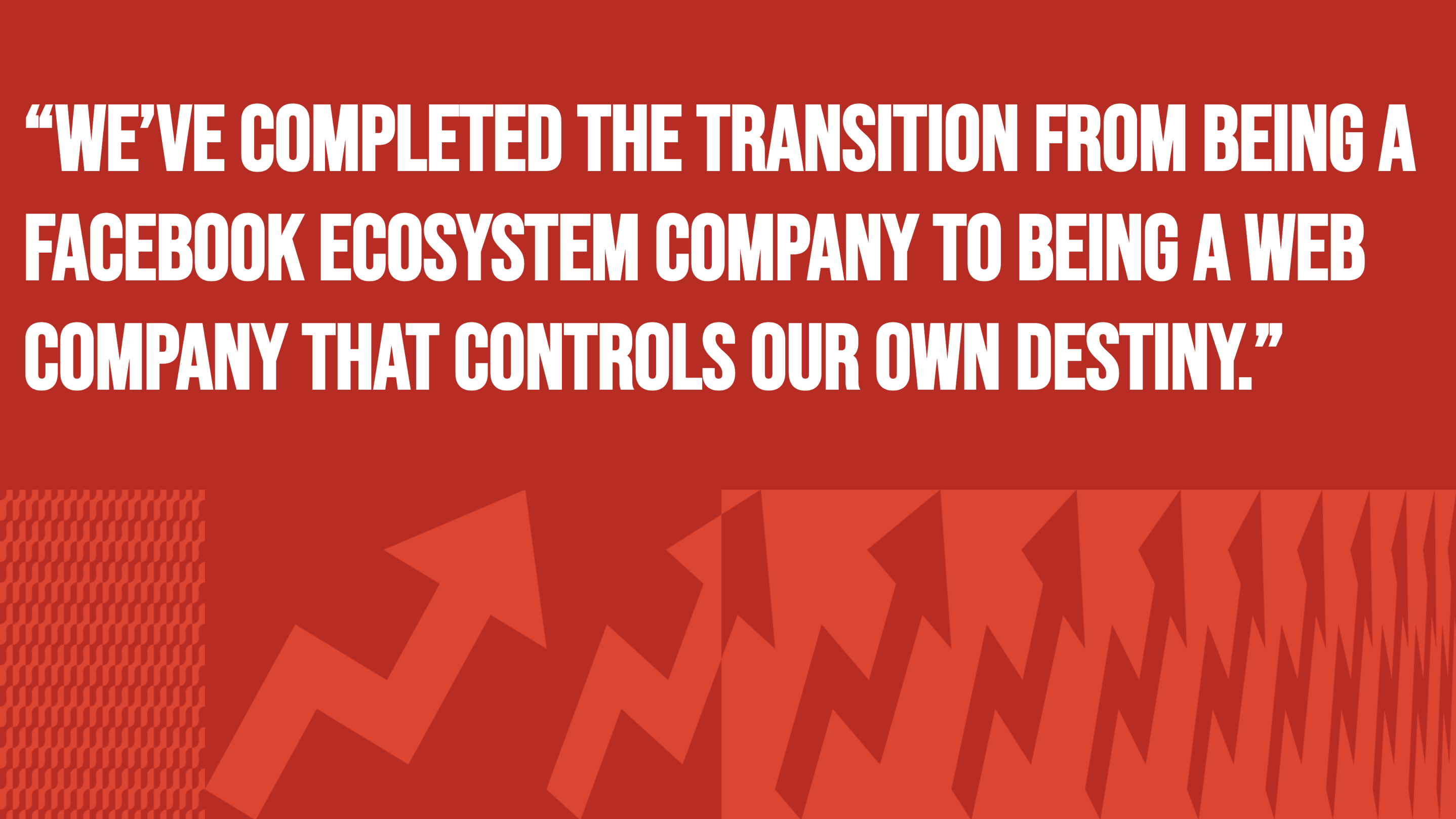
More recently, we’ve also seen a positive shift in the dynamics of our core audience to favor deeper engagement on our own sites and apps, with a desire for new forms of creative content. Across the BuzzFeed site and app, time spent per pageview grew quarter-over-quarter in Q3 and again in Q4 2023. And time spent per pageview with our AI-powered content has significantly outperformed static content. Our audience loves that we’ve created a special place on the internet that feels like home, where they belong, can have fun, and we are just getting started applying AI to our site and app to make the experience even better. Resetting our strategic direction to focus on our owned and operated sites and apps allows us to directly benefit from the application of technology to our business, especially GenAI.
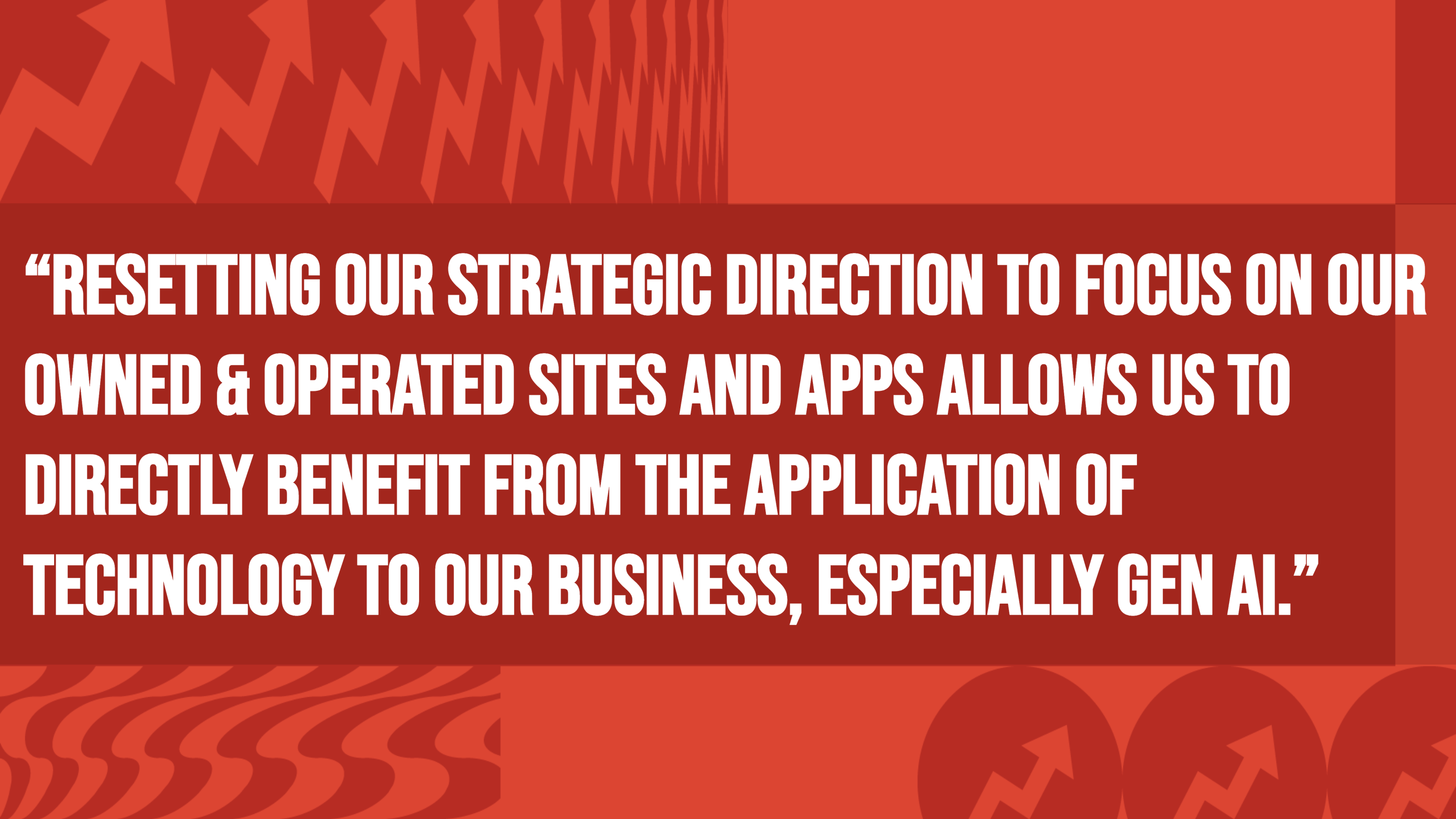
This new direction also allows us to focus on the parts of our business that are high margin, scalable, and tech-enabled, specifically programmatic advertising and affiliate commerce. In 2023, our programmatic advertising business brought in approximately $90 million and returned to year-over-year growth on our owned and operated properties in the second half of 2023 despite a tough market. Similarly, our strong affiliate business drove over $500 million in sales for our retail partners which generated approximately $50 million in revenue for us in 2023. Both these business lines are poised to benefit from the application of Gen AI, which is now capable of reading and understanding our content, creating new opportunities for automating contextually aligned advertising and personalized shopping. In areas where our teams have control over monetization and aren’t constrained by platform dependencies, we drive strong performance and have the ability to innovate. Looking ahead, our focus on our owned platforms will be the key to continuing these positive trends.

We are just at the start of this work and are very excited about how this technology can further optimize our core business lines. Our first experiment with a personalized, AI-powered content module in our app boosted pageviews by 24%, thereby increasing both transactions and revenue because we were able to match users with the content (and products) we know they like. This is just one small step in forging a system of personalization that will make our sites and apps more rewarding, engaging and fun for users.

PIONEERING THE NEXT REVOLUTION IN DIGITAL MEDIA
When technology enables a new medium, people usually make the mistake of cramming the old medium in the new box. When TV first arrived, media companies used it to broadcast radio programs or pre-recorded theatrical plays. Watching a play on TV isn’t a great way to use the medium, and eventually TV developed its own conventions of close ups, quick cuts, and scene changes.
The same mistake is being made with AI right now. It is being used by some misguided publishers to generate static articles — using a new medium to mimic a legacy medium. This mistake is made again and again throughout history, and the key to success is to explore relentlessly until you find things that are only possible in the new medium and then lean into them to create magic.
We are starting with a deeper understanding of how a new medium is born on the internet. We did this before when we helped pioneer “social content” so we have a proven playbook. Our company brings together creative editorial teams who are tech-literate with technology teams that are creative - a unique combination to invent the future of AI content. These types of collaborative, cross-disciplinary teams are lacking at the big tech companies and the traditional media companies. And we have a highly engaged audience who loves our brand and expects us to surprise and delight them with new forms of content.
We are off to a great start with these explorations. Not many know this, but we published some of our first AI experiments as early as 2018, including the Obama Deep Fake PSA video that is still widely referenced by thought leaders, researchers and academics across the AI space today. We’ve been experimenting with this emerging technology ever since, with a focus on rapid testing, learning and iterating to grasp new understandings and wider applications of AI for our content. To date, we’ve built a bunch of experiences that are very difficult or impossible without AI.
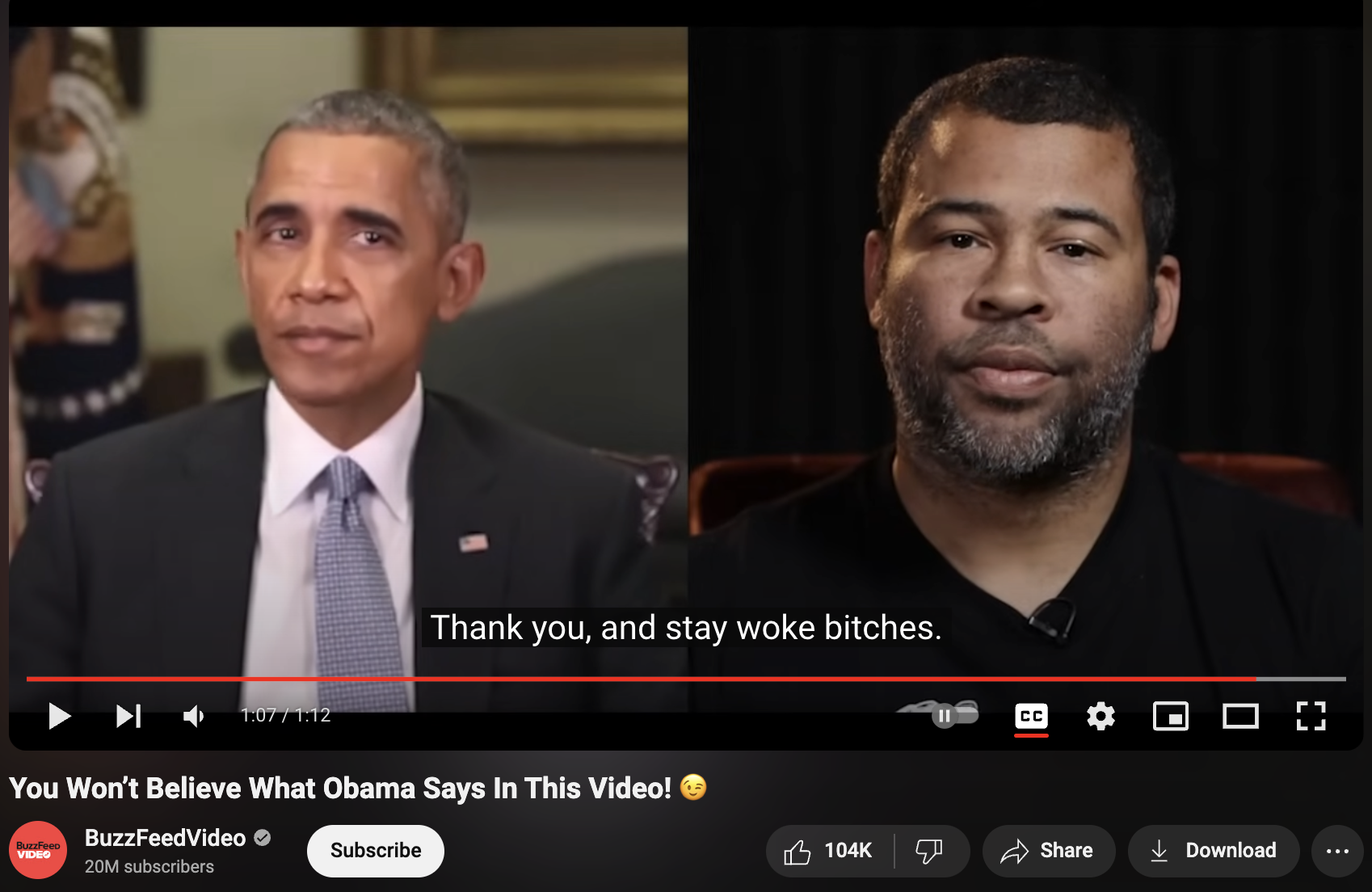
We started with “infinity” quizzes like What Town Should You Live in Based on Your Lifestyle and AI-image creations like 50 States of Barbie Dreamhouse. We then expanded to chatbot style games and characters like our Nepo Baby simulation game Nepogotchi, which saw twice as much time spent per pageview when compared to our static content published in 2023. We also launched utility-focused AI products, like Shoppy, an AI assistant that helped our audience find the perfect holiday gift for everyone on their list. We also created a new “content engine” format: a custom Emoji Generator, which skyrocketed to join the top 10 most-engaged BuzzFeed posts of all time.
The test-and-learn phase has given way to a deeper understanding of the landscape, the preferences of our audience and the potential for this medium. It’s clear that users aren’t as excited by the static, unimaginative uses of AI, but are hungry for the more creative and responsive potential that the technology enables. Even though we are just getting started on this journey, we see opportunities for this technology to enable new levels of personalization that not only understand user preferences but respond to real-time changes in mood or interests.
We are at the start of creating an entirely new medium that is so responsive and dynamic that our content and platform will feel almost alive. And while hyper-personalized algorithms of the major platforms can be isolating, we see this medium as a way to build and enhance communities of people, through content and experiences that build on social relationships and shared interests, in much the same way that social content was once made to share. We think there are ways to unlock new forms of storytelling and imagination, create conversational media, and endlessly remix and evolve the creative output of our teams and our audience. In the near future, we will bring this work together into a reimagined BuzzFeed web and app experience as we continue to push the boundaries of what is possible with AI and drive the industry forward. I can’t wait to show our audience what we are building next.
BUILDING THE DEFINING MEDIA COMPANY FOR THE AI ERA
As you will see in the accompanying financial statements presented within our Annual Report, 2023 was a challenging year for our business and digital publishing more broadly. As competition for audience time between the platforms intensified and advertisers contended with uncertainty in the market, we were impacted. On a continuing operations basis, excluding Complex, our 2023 revenues declined 26% to $253 million, which was accompanied by an Adjusted EBITDA loss of $5 million, as compared to approximately breakeven in 2022.
To be clear, we are not satisfied with this performance. And, earlier this year, we made key strategic and organizational changes to address this. Specifically, we:
- sold Complex, bringing in nine-figures of liquidity and reducing our exposure to lower-margin revenue streams with lower demand in a tighter digital ad market
- paid down a portion of our debt and reduced our cash interest expense obligations
- restructured our organization to reduce centralized costs and direct more dedicated resources to our individual brands
- refocused our business around our owned and operated websites and apps, where we have more control over monetization and user experience, and
- prioritized our most scalable, highest-margin and tech-led revenue streams: (1) programmatic advertising and (2) affiliate commerce.
These changes created a new foundation for the company, providing a platform to begin transforming our business in the coming years. Following these changes, BuzzFeed, Inc. is stronger and poised to capitalize on the emergence of GenAI to build the defining media company for the AI era.
Before I wrap up, I want to share a final thought. We had a choice when we reset BuzzFeed’s strategic direction earlier this year. We could have become more of a media company, more of a content company or more of an agency to make content for clients. We chose to move in the opposite direction to become more of a tech company. The reason is because the “tech way of thinking” - the implicit ideas that underlie the industry - are what will end up defining our shared future. Companies grow and thrive when they prize scalability, technological leverage, zero marginal costs, machine learning and positive feedback loops. There is a reason TikTok beat Quibi. Or Netflix outcompeted all the big media companies. Even Disney was originally led by a technologist who invented a new medium, creating the first animated feature film with Snow White.
Tech billionaires may say dumb things sometimes, but the core *ideas* behind the tech industry, and the pursuit of scalability and technological leverage, provide the best path to: grow a company, have a big impact and, in our case, spread truth, joy, and creativity on the internet.
We are an ambitious company, and we aren’t satisfied with simply making commodity content for the platforms. We’ve always been as obsessed with the medium as we are with the message. We are determined to build the future of media and we are adjusting our strategy accordingly.
As we embark on the next stage of our journey, I want to welcome all the new shareholders who are joining us and supporting our next stage of growth. We are committed to delivering for you and creating value the best way we know how - by innovating to push the digital media industry forward.
I can’t wait for what’s next.
You can read BuzzFeed, Inc's full 2023 Annual Report here.

